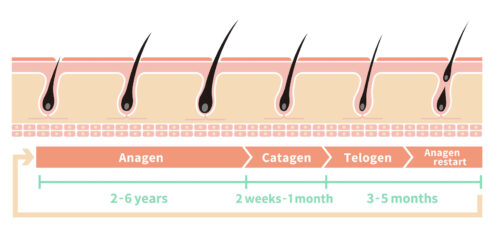
Understanding Hair Growth
There are approximately 80,000 to 150,000 follicles on the human scalp, however, not all are productive at the same time. Hair growth is cyclical, and the hair grows for around 1,000 days (3 years) and then rests for about 100 days (3 months). The ‘hair cycle’ varies between individuals and is influenced by age, diet, health, etc. When resting, the old hair from the last ‘hair cycle’ remains in the follicle and, if not dislodged by daily hair care procedures, is displaced by the new hair as it grows up the follicle. Hair length is controlled by the length of the growing phase, which is called ‘anagen’. The hair growth rate is approximately half an inch (1.2 cm) per month and so if you have a growing phase of say 2 years, then your hair will grow to approximately 12 inches (29 cm). With very long growth phases, the hair can actually grow down to your feet!
Each scalp hair follicle is independent and while one hair may be growing, the next may be resting. Unlike birds and some animals, humans have no recognized molting periods, although those living in latitudes where wide variations in day length occur (such as Scandinavia), there has been some seasonal shedding observed.
It is natural to lose hair each day when brushing, combing, or shampooing. Around 50 to 150 hairs can be shed normally and, while there is a wide individual variation, it is the change within an individual that is critical if you are concerned about excessive hair loss. As long as new hairs are being produced at the same rate as those falling out, there will be no difference in hair density. However, if shedding is greater than production, hair loss occurs. For example, if an individual has been losing 50 hairs per day and this increases to 100, twice as many hairs would be observed when combing or shampooing. Although 100 hairs are still within the normal range, for this individual it represents a worrying 100% increase and consequently noticeable hair shedding.
Hair thickness varies between individuals, with some people having finer (or thinner) hairs than others. As we grow older, there is a tendency for our hair fibers to become finer and shorter over successive cycles, but years may elapse before any obvious difference is seen.
Hair volume is determined by three factors: the number of hairs present per square centimeter, the proportion of hairs in the growing phase, and hair fiber diameter (thickness). These factors change when hair loss occurs. Almost all hair disturbances can be characterized by a change in one or any combination of these three aspects, so understanding what has changed is the key to identifying the underlying cause.
